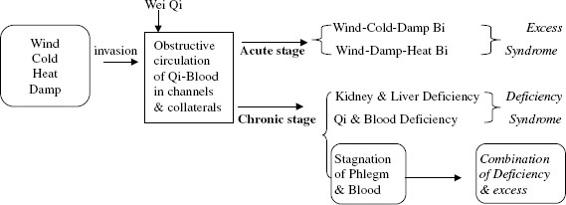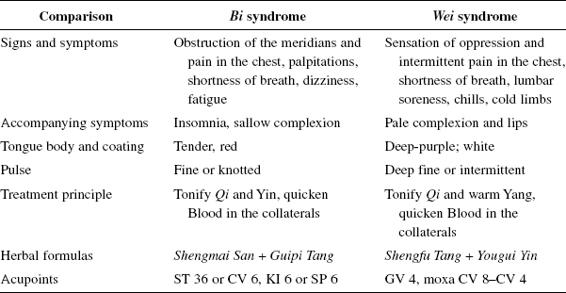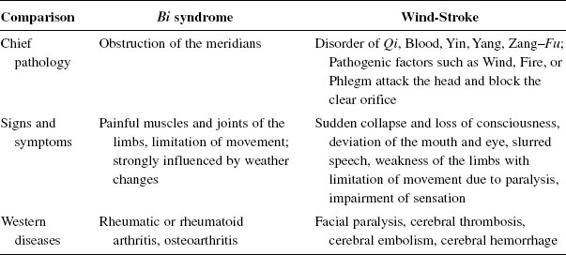The Introduction of Bi Syndrome (痹症)
Bi Syndrome (also known as Arthralgia Syndrome, a painful obstruction syndrome) is characterized by obstruction of Qi and Blood in the meridians and collaterals due to invasion of exogenous pathogenic factors and manifested by soreness, pain, numbness, a heavy sensation of the body, limbs, joints, and muscles, and limitation of movement. It is called Bi Zheng  in TCM. “Bi” means “obstruction” and “Zheng” means “syndrome” (Etiology and pathology of Bi Syndromes).
in TCM. “Bi” means “obstruction” and “Zheng” means “syndrome” (Etiology and pathology of Bi Syndromes).
TCM has a long history of successfully treating Bi Syndrome. The Inner Canon of the Yellow Emperor (Huang Di Nei Jing) had from early times established the theoretical foundations upon which the treatment of Bi Syndrome should be based in TCM. For example, the “Simple Questions” (“Su Wen”) in Chapter 43 — “Discussion on Bi Syndrome” states that “Bi Syndrome is due to the combined invasion of Wind, Cold and Dampness.” “Dominance of Wind invasion causes Wandering Bi Syndrome; or Cold and Painful Bi; or Damp and Fixed Bi.” Following these guidelines, TCM physicians in China have progressively developed such theories, and produced more specialized prescriptions dealing with each specific type of Bi Syndrome according to etiology, stage, or particular signs and symptoms.
In the past few decades, modern TCM physicians have focused on research of historical literature and raised protocols to an advanced level. The combined historical and modern research has resulted in great progress in the treatment of rheumatic diseases.
Bi Syndrome is a very broad topic. It has been classified into many sub-types, according to different criteria, since very ancient times. Bi Syndrome has been divided into Wind-, Cold-, Damp-, and Heat-Bi Syndrome according to etiology; it can be classified as Wandering Bi, Painful Bi, and Fixed Bi Syndrome according to characteristics of manifestation; or as Skin Bi, Muscle Bi, Tendon Bi, Vessel Bi, and Bone Bi according to affection of the five tissues; or it can also be classified into Lung Bi, Spleen Bi, Liver Bi, Heart Bi and Kidney Bi according to affection of the five Zang organs. The classification of Bi Syndrome based on etiology and/or manifestation is most commonly used nowadays.

Etiology and Pathology (Etiology and pathology of Bi Syndromes)
(1)Pain

(2)Numbness
(3)Limitation of movement
(4)Swelling and deformity of joints
Differentiation
1) Differentiation of diseases
- Differentiation between Bi Syndrome and Wei Syndrome (see Table 1).
- Differentiation between Bi Syndrome and Wind-Stroke (see Table 2).
2) Differentiation of syndromes (see Table 4)


Treatment
1) Principles of treatment
2) Herbal formulas
3) Patent medicine
4) Acupuncture
5) Other remedies
How to prevent Bi Syndrome
Patients should keep themselves warm and avoid wet or humid dwelling places. They should avoid excessive sexual activity and promote regular physical training to activate the circulation of Qi and Blood. Moreover, they should avoid eating too much food, especially fatty or fried food, and drinking alcohol. They are encouraged to take certain herbs or accept acupuncture treatment on a regular basis to prevent Bi Syndrome.
Suggestions
Both acupuncture and Chinese herbal medicines are very effective in treating Bi Syndrome. Acupuncture, in particular, gives quick relief in both acute and chronic cases. However, it is still a challenge to treat recurrent cases with deformity of the joints. A comprehensive treatment combined with herbal medicine or Tuina massage is highly recommended.

